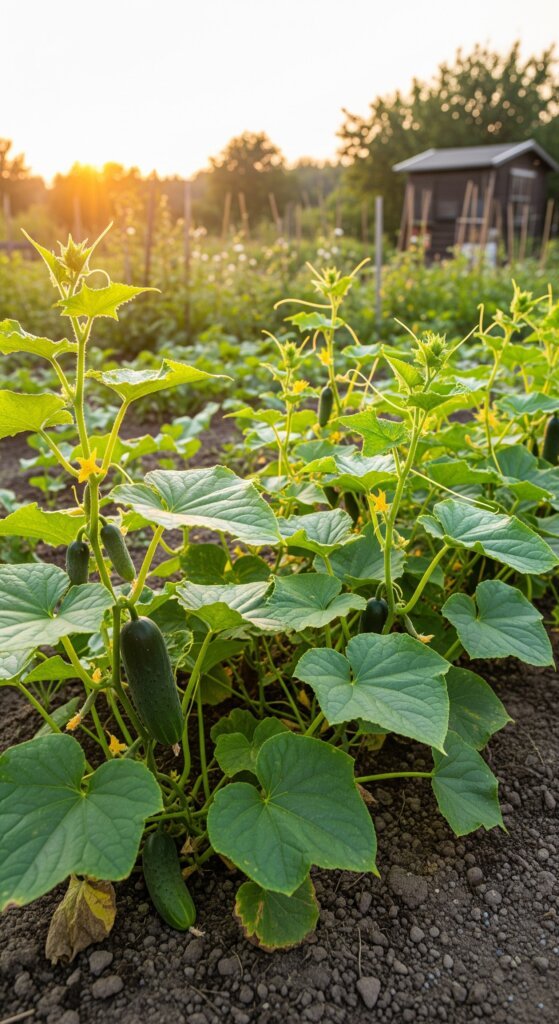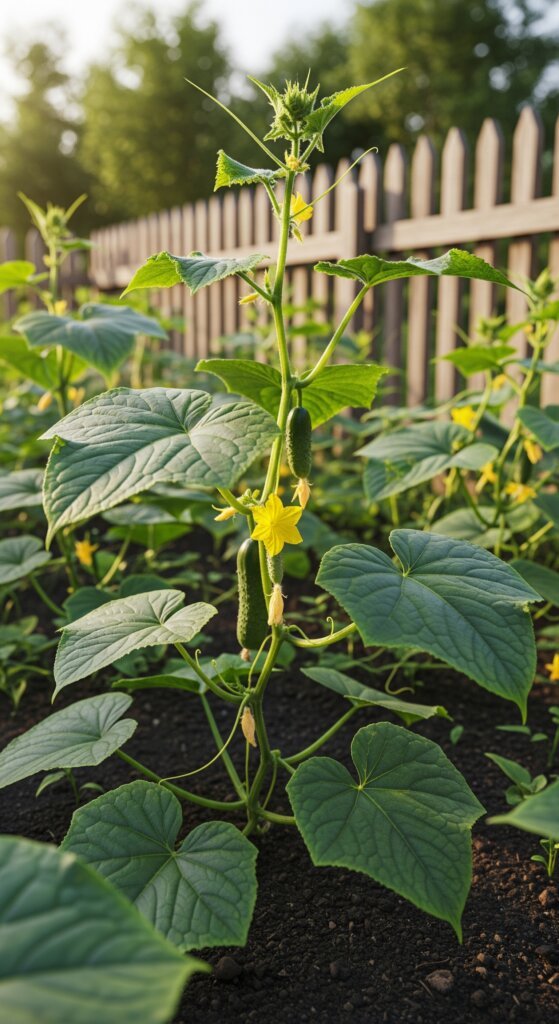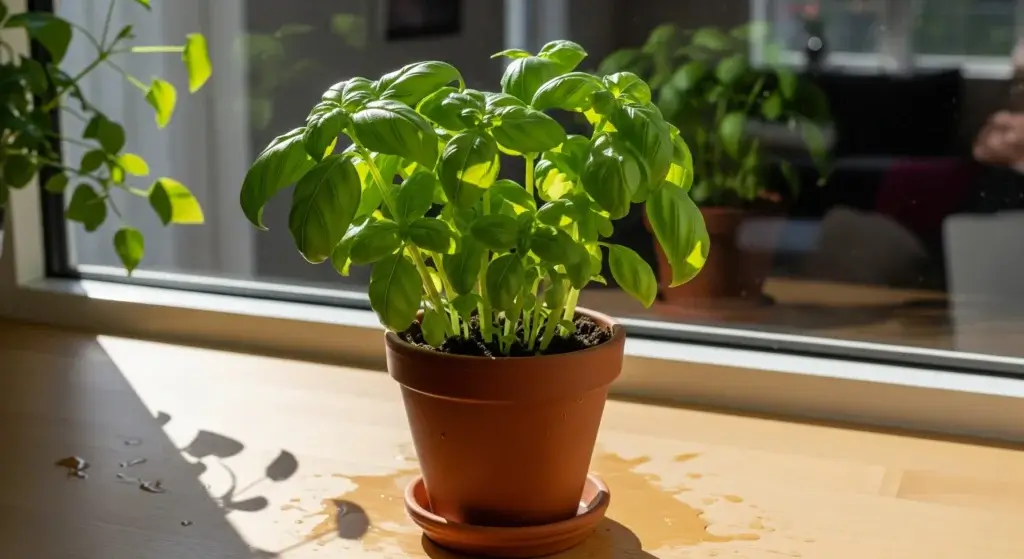
Want healthy, high-yield cucumbers without going full Breaking Bad in your garden? You’re in luck.
Whether you’re a seasoned plant parent or just figured out what end of the trowel to hold, this guide shows you how to protect your cukes the natural way—no sketchy sprays, no drama.
We’ll cover pest hacks, disease blockers, and stress-busting tips so your cucumbers thrive and keep the bees buzzing with joy.
Let’s grow like pros—minus the chemicals.
Understanding Cucumber Vulnerabilities
Before we gear up to defend your cucumber patch, you’ve gotta know what you’re up against.
Cukes might look chill, but their growing season is basically a survival show.
We’re talking aphids—those tiny green vampires that suck sap and spread plant viruses.
Then there are cucumber beetles, which not only munch leaves like it’s a salad bar but also carry bacterial wilt (a total plant killer).
And don’t forget powdery mildew, the clingy white fungus that loves humidity like it’s a sauna spa day.
But it’s not just bugs and germs. Nature likes to throw curveballs too.
Wild swings in weather, overwatering, underwatering, swampy soil, or planting them so close they can’t breathe—all of it stresses your plants out.
And stressed cucumbers? They’re basically sending out an open invite to pests and disease.
The Power of Companion Planting
Want to keep your cucumbers safe without spraying mystery goo on them?
Time to call in reinforcements—plant buddies, that is. Companion planting is basically the Avengers of the garden world.
Certain plants team up to help cucumbers grow stronger, fight pests, and boost yields (minus the superhero capes).
Start with the nitrogen crew: peas, beans, lentils, and corn.
These guys improve the soil while helping your cukes bulk up.
Bonus: tall corn stalks double as cucumber jungle gyms for vining types. Efficient and adorable.
Then bring in the herb squad.
Basil, parsley, and chervil aren’t just tasty—they’re tiny pest-repelling ninjas.
They help fend off bugs and even diseases like powdery mildew.
Marigolds, nasturtiums, and catnip? They’re like VIP security, chasing off bad bugs while rolling out the red carpet for pollinators and predator insects that eat the troublemakers.
Just don’t crowd the party. Give everyone enough room to breathe and grow—no one likes being shoulder-to-leaf.
You can border your cucumber patch with herbs, or mix them in between rows like bodyguards on patrol.

Natural Pest Control Solutions
Let’s be real—bugs love cucumbers almost as much as you do.
But before you break out the chemical warfare, try these natural moves that keep pests in check without turning your garden into a toxic zone.
Step 1: Block the baddies
Start with row covers—think of them as cucumber force fields.
These light fabric blankets let sunshine, air, and water through but stop flying insects in their tracks.
Just cover your plants right after planting, then take them off once flowers show up so bees can do their thing.
Now for a cool trick: kaolin clay.
It’s basically a bug blinder. When cucumber beetles crawl over it, it gums up their antennae so they get lost and give up.
Spray it on like a fine white dust jacket—bugs hate it, but your plants won’t mind.
Step 2: Organic spray solutions
Forget harsh sprays—these natural options get the job done without hurting the good guys (like bees and ladybugs).
- Neem oil: It’s the pest version of a reality show twist—totally messes with bugs’ life cycles. Stops them from eating, growing, or reproducing.
- Garlic spray: Bugs hate the smell of garlic (just like vampires, right?). Blend a few cloves with water, strain, add a drop of soap, and spritz away.
- Soapy water: Got aphids? Spray them with a soap-and-water mix, then rinse. Easy.
- Bonus hacks: Try planting cukes in beds covered with aluminum foil or set out yellow bowls of water to trap them—like a pest pool party they won’t survive.
Disease Prevention Strategies
Wanna keep cucumber diseases out of your garden drama?
Think of this as your plant’s wellness routine—no meds, just smart habits.
Step 1: Break the cycle
Don’t let diseases settle in like a bad sequel. Rotate your crops!
If you planted cucumbers (or their cousins like squash, melons, or pumpkins) in one spot, give that bed a break for 3–4 years.
Grow something totally unrelated there instead—beans, lettuce, literally not a vine.
Step 2: Let them breathe
Fungal diseases love hot, sticky, crowded places (think locker room energy).
So space your plants out and don’t cram them together.
For vining types, use a trellis to lift the leaves off the ground and give them room to breathe.
Also, water the soil, not the leaves—no one likes soggy sleeves, especially not your plants.
Step 3: Feed the soil, not just the plant
Cucumbers growing in rich, healthy soil are basically on plant vitamins.
Compost, aged manure, leaf mold—these are the good vibes your soil needs.
They boost drainage, feed your plants, and invite helpful microbes to hang out in the root zone and keep bad guys in check.

Beneficial Insect Habitat Creation
Want fewer pests without lifting a spray bottle? Bring in the good bugs and let them do the dirty work.
Think of it as hiring a natural pest control crew—no paycheck, no chemicals, just free labor.
Nematodes.
These microscopic worm-things are your secret weapon.
You add them to your soil, and they go full Mission: Impossible on cucumber beetle larvae—sneaking in, taking them out, and vanishing underground.
You won’t see them, but your plants will feel the difference.
Attract the good guys
Ladybugs, lacewings, parasitic wasps—they’re not just cute names; they’re cucumber bodyguards.
Want them to stick around? Plant a buffet.
Go for native flowers, herbs that you let bloom (yep, let that cilantro go wild), and perennials that bloom in waves all season.
That’s how you keep the insect party going.
Hydration station
Even bugs get thirsty. Set out shallow water dishes with pebbles—like tiny bug spas.
It’s low-effort, and beneficials will thank you by chomping down on the pests you don’t want.
Build them a bugbnb
Give them a place to crash! You can DIY bug hotels from hollow stems, drilled logs, or pick up a pre-made one at the garden center.
These cozy hideouts help your insect crew overwinter—so they’re back on patrol first thing next season.
Environmental Management Techniques
Your cucumbers aren’t divas—but they do get cranky when they’re too wet, too dry, too hot, or too cold.
Think of them like Goldilocks.
They just want it juuust right. Here’s how to keep their environment in the sweet spot.
Water management
Skip the sprinkler drama.
Overhead watering soaks the leaves and practically invites fungal diseases to move in (especially at night—aka the fungus happy hour).
Instead, go low and slow with drip irrigation or soaker hoses. Water the soil, not the leaves.
Add mulch—your cucumber’s version of a weighted blanket.
It locks in moisture, keeps roots cool, and kicks weeds to the curb.
And don’t water like a nervous helicopter parent—deep, infrequent watering encourages roots to grow strong and go deep. Shallow roots = wimpy plants.
Temperature and season extension
Cucumbers don’t do well in wild temperature swings.
So if the weather acts like it’s in a mood, you’ve got options.
- Cool out? Use a cold frame, hoop house, or floating row cover to keep them cozy.
- Scorching heat? Throw some afternoon shade with tall companions (like corn or sunflowers) or shade cloth. It’s like SPF for your plants.
- Live somewhere hotter than a jalapeño’s temper? Grow heat-loving cucumber varieties that can take the sizzle.

Integrated Natural Protection Systems
Here’s the truth: no single trick is gonna keep your cukes safe. You need a team.
The best natural protection system is like a layered burrito—each ingredient adds flavor and strength.
So don’t just rotate crops and call it a day. Go all-in.
- Start at the roots: Build up healthy soil, pick strong cucumber varieties, and plant them next to helpful buddies (shoutout to basil and beans).
- Stack on the armor: Use row covers to block bugs, spray neem or garlic if needed, and keep the beneficial bugs happy with flowering herbs and bug hotels.
- Monitoring is key: Check your plants often, like you’re catching a drama series early. Spot a pest or weird leaf? Act fast before it turns into a full-blown garden soap opera.
- Take notes: Write down what worked, what flopped, and what had the cucumber beetles running scared. Next season, you’ll be smarter, faster, and way more ready.
Seasonal Implementation Timeline
Wanna grow cucumbers like a total garden boss? Timing’s everything.
Here’s your no-stress, all-natural roadmap from spring prep to final harvest—because your cucumbers deserve VIP treatment all season long.
Spring preparation
- Feed your soil with compost and other goodies. Healthy soil = strong plants.
- Map out your companion planting dream team—basil, beans, marigolds, the whole crew.
- Throw on row covers like cucumber armor—keeps the bugs out while your plants get cozy.
- Start setting up bug-friendly spaces—wildflowers, shallow water, maybe a bug hotel (yes, that’s a thing).
Early summer management
- Pull off those row covers once flowers show up—it’s pollination time, baby!
- Start pest patrol—walk your garden like a detective with a spray bottle.
- Hit ‘em early with neem or garlic spray if bugs crash the party.
- Stick to a solid watering routine—deep and focused, not splashy and random.
Mid to late summer maintenance
- Stay on pest watch—consistency beats crisis.
- Pick cucumbers often—they grow fast and get weirdly huge if you blink.
- Keep the bug squad happy—let herbs bloom, refill water dishes, fluff the bug hotel pillows.
- Start thinking about cleanup—pull sick plants early, prep beds for the fall.

Troubleshooting Common Issues
So you’re doing all the right natural things—companion planting, spraying neem, calling in the bug squad—but your cukes still look stressed or buggy? Don’t panic. I
t’s time to play garden detective.
First, check the basics:
- Are your plants spaced out enough? Crowded cukes = fungal hotspot.
- Did you actually use that garlic spray… or just think about it?
- Are you watering like a plant parent or firehosing them into fungal oblivion?
Next, zoom out:
- Got a neighbor who treats their garden like a pest Airbnb? Those bugs don’t respect fences.
- Was the weather extra weird this year? Heat waves, cold snaps, or random floods mess with plant vibes.
- How’s your soil? Run a test—low nutrients or bad pH can sabotage everything.
Sometimes it’s not one thing—it’s timing, or a combo move you didn’t try yet. Layer your defenses. Tweak your routine. Cucumber success is more remix than recipe.
Maximizing Long-term Success
Natural cucumber care isn’t a quick fix—it’s more like building a garden ecosystem that gets stronger every year. Be patient.
Bugs might take a little longer to back off, but once the good guys settle in, you’ll see steady, long-term wins.
Keep notes each season—what worked, what didn’t, what made your cucumbers pop off.
Treat it like your garden cheat code for next year.
And don’t garden in a bubble—swap tips with fellow growers online or at your local plant swap. There’s no shame in stealing great ideas.



